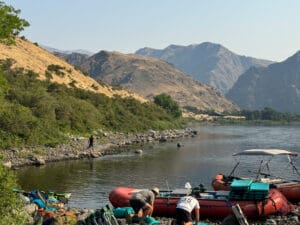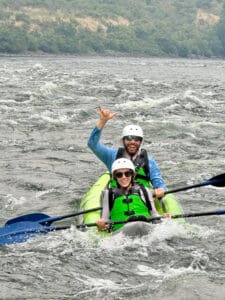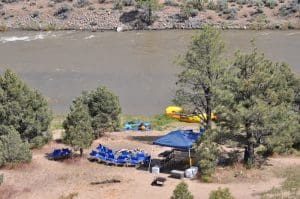For the first time in more than a century, the Klamath River flows freely, its natural course restored. This marks the culmination of the largest dam removal project in U.S. history, a project that has been years in the making and is nothing short of historic for the river, its wildlife, and the Indigenous tribes who have called this region home for generations.
On Wednesday, August 28th 2024, crews breached the final dams on a key section of the river, using excavators to remove the rock barriers that had long diverted water upstream of the Iron Gate and Copco No. 1 dams. Each scoop of earth brought the river one step closer to its natural state. By the end of the day, the Klamath River had reclaimed its path, rushing through channels that had been blocked for decades. This work couldn’t have come at a better time. The fall Chinook salmon, also known as king salmon, are returning to spawn, and now, for the first time in generations, they will have access to hundreds of miles of prime spawning grounds that were once cut off. “Another wall fell today. The dams that have divided the basin are now gone, and the river is free,” said Frankie Myers as quoted in The Guardian, vice-chairman of the Yurok Tribe, which has been at the forefront of efforts to restore the Klamath River. “Our sacred duty to our children, our ancestors, and for ourselves, is to take care of the river, and today’s events represent a fulfillment of that obligation.”
The Klamath River has always been more than just a waterway. For the Yurok, Karuk, and Hoopa Valley Tribes, the river is a lifeblood, central to their culture and way of life. Salmon, in particular, hold deep cultural and spiritual significance. The decline in salmon populations over the last century—due largely to the construction of dams—has had devastating impacts on tribal communities who rely on the fish for sustenance and tradition. The removal of the dams represents more than just environmental restoration; it’s a cultural revival. “Restoring hundreds of miles of spawning grounds and improving water quality will help support the return of our salmon, a healthy, sustainable food source for several Tribal Nations,” said Russell “Buster” Attebery in a recent Guardian article, chairman of the Karuk Tribe.
The Klamath River, once the third-largest salmon-producing river on the West Coast, had its ecosystem dramatically altered by the construction of six hydroelectric dams in the 20th century. These dams blocked salmon from reaching their native spawning grounds and stagnated the river’s flow, causing water temperatures to rise and contributing to disease outbreaks among fish populations. In 2002, a bacterial outbreak killed more than 34,000 fish, mostly Chinook salmon, and signaled just how dire the situation had become. After decades of advocacy by tribes and environmental groups, the removal of the Iron Gate, Copco No. 1, Copco No. 2, and JC Boyle dams was finally approved in 2022. Crews began removing the smallest dam, Copco No. 2, in 2023, followed by the draining of the reservoirs behind the remaining dams. By early 2024, water was flowing freely through much of the Klamath River, and by August 28th, the last dams were gone. The environmental benefits are already being felt. According to data gathered by the Karuk Tribe, oxygen saturation levels have improved, turbidity is decreasing, and overall water quality is showing signs of recovery. Although it will take time for the river’s ecosystem to fully heal, the early indicators are promising.
While the dam removal project is a monumental achievement, the river’s restoration journey is far from over. It will take years, perhaps even decades, for the Klamath to fully recover from more than a century of disruption. But with the dams gone, the river now has a fighting chance. Salmon populations will be the primary beneficiaries of this restoration effort. While it’s unclear exactly how quickly they will return to their historical spawning grounds, early signs are encouraging. There have already been reports of salmon near the mouth of the river, preparing to make their journey upstream. Experts are hopeful that we will see fish reaching the newly accessible sections of the river within the next year. “I think we’re going to have some early successes,” stated Michael Belchik in a Guardian article. Belchik is a senior water policy analyst for the Yurok Tribe. “If not this year, then for sure next year.” The restoration of the Klamath River will also open up new opportunities for recreation, including whitewater rafting and fishing. However, there will be short-term impacts on rafting opportunities. Without the steady water releases from the dams, rafting trips on the Upper Klamath will now depend on the river’s natural flow, which may limit trips to the spring season. That said, the potential for new multi-day trips and access points near the removed dams is already being explored.
The Klamath River dam removal project is a reminder of the power of persistence and collaboration. What started as a grassroots effort by Indigenous tribes has grown into the largest dam removal project in U.S. history. And while there is still work to be done to fully restore the river, the removal of these dams is a critical first step. As Mark Bransom, chief executive of the Klamath River Renewal Corporation, aptly put it in The Guardian article: “You can’t undo 100 years’ worth of damage and impacts to a river system overnight.” But with the dams gone, the river is finally free to heal, and the salmon are one step closer to coming home. For those of us who cherish the Klamath River and all it represents, this is only the beginning of a new chapter—one of restoration, revival, and resilience. And it’s a chapter we’re proud to be part of.
References: Golden, H. (2024, August 29th) ‘The river is free’: historic US dam removal nears completion
For more information, read our Klamath Dam blog series, links below.
Klamath River Dam Removal Project Update: April 22, 2024
Klamath River Dam Removal Project Update: August 5, 2023
Klamath River Dam Removal Project Begins: May 8, 2023





